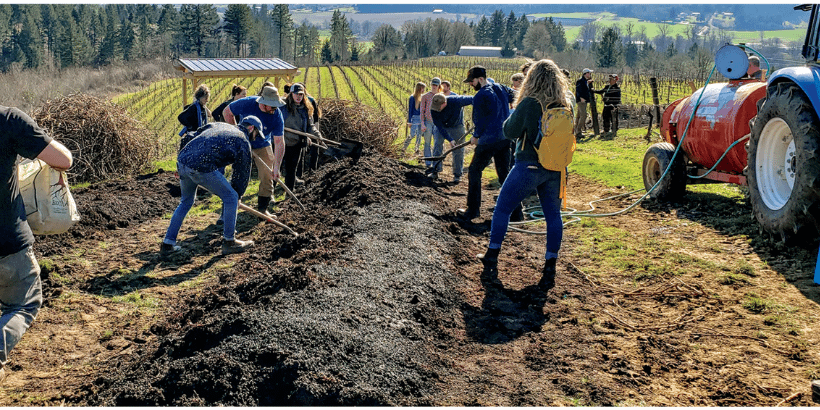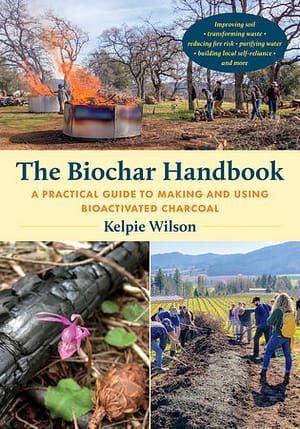What is Biochar and How Does it Work?

Some of the most productive and resilient soils in the world contain significant quantities of “natural” biochar. Like many human discoveries, biochar has likely been invented, lost, and reinvented multiple times. It’s the oldest new soil enhancer that you’ve never heard of!
Biochar is a stable solid that is rich in carbon and is made from organic waste material that improve soil fertility, horticultural yields and sequesters carbon simultaneously. By the simple process of burning organic material in a low-oxygen, low-emission environment it could be one of the most powerful tools we have to restore degraded soils and reduce our dependence on fossil fuels.
The following is an excerpt from The Biochar Handbook by Kelpie Wilson. It has been adapted for the web.
When biochar came on the soil science scene early in the 2000s, what made its entrance so dramatic was the vivid contrast between the rich, dark earth that could grow crops, and the native soil: highly leached, yellow-red oxisols that could barely support a weed once the overlying jungle vegetation was wiped away. In these tropical rainforests, almost all of the carbon is contained in the living biomass.
When a leaf falls to the ground, it is consumed almost immediately by hungry creatures. Carbon and nutrients cycle quickly and relentlessly as things eat and get eaten. Constant rain washes soluble nutrients into the ground where microbes and roots feed. Very little is left over to be stored in soil.
In contrast, a northern boreal forest builds up thick layers of peat made of partially decomposed plant matter. It is too cold and dry for life to be very active and carbon accumulates in the soil.
When I visited the Amazon with the International Biochar Initiative in 2010, we toured an organic farm growing fruits and vegetables for the city of Manaus, Brazil, 50 kilometers downriver. Walking through the rows of tomatoes, peppers, and papaya trees, I could see pottery shards scattered everywhere on the surface of the dark soil. These modern-day farmers were reaping the legacy of perhaps thousands of years of soil building by the Indigenous Amazonians.
The value of the land was reflected in the property value: Land with terra preta soil sold for eight times the price of lesser farmland. We spent a day on the farm looking at different areas where the soil was more or less enriched with biochar and saw a 60-foot-tall orange tree growing in the terra preta soil.
But what makes biochar so valuable? How does it work, and how can we use it to start our own soil-building processes?
Biochar is a heterogeneous and chemically complex material, and its actions in soil are difficult to tease apart and explain mechanistically. While there are now multiyear field studies that show the beneficial impact of biochar on different crops, it is difficult to draw broad conclusions from these studies because they use different kinds of biochar in different types of soil with different crops. To really understand biochar, it is perhaps more useful to look first at some general functions and properties of biochar.
The Role of Carbon in Soil
To understand biochar, we must first appreciate the role of soil carbon. Soil carbon comes in many forms. There are two main pools of carbon: organic and inorganic. Organic forms can be further divided into recalcitrant carbon and labile carbon. Recalcitrant carbon is stubborn carbon that does not like to change its form, because it is already chemically stable. Labile carbon is mobile and changeable. Labile carbon is bioavailable (in the form of easily degraded compounds such as oils, sugars, and alcohols) and physically accessible to microbes (not bound up with minerals). The organic carbon pool includes both the living bodies and the dead, decomposing bodies of bacteria, fungi, insects, and worms, along with plant debris and manure.

The evolution of soil shows how the soil-building process works.
Before photosynthetic bacteria transformed Earth’s atmosphere by filling it with oxygen, soil was nothing more than a mineral mixture of anoxic green clays. After oxygen entered the atmosphere, minerals started reacting with the oxygen, and red iron oxides appeared in the soil. Good organic, rich, productive soils developed slowly, only after algae and arthropods crawled from the sea to dry land and plants took root. Life colonized land and began shedding its wasted, used-up, discarded parts onto the earth, where they formed a carbonrich banquet that allowed new life to feed and grow, using photosynthesis to pump ever more energy into the system.
Soil building is the product of a self-reinforcing, positive feedback loop—a virtuous cycle. But soil decline is also a self-reinforcing loop (a vicious cycle) that can result in catastrophic soil loss. Most forms of agriculture tend to deplete soil carbon by reducing the amount of natural organic inputs from leaf and fruit fall as well as from woody debris, as would be found in native ecosystems.
However, modern, chemical-based agriculture depletes soil carbon much more drastically. Nitrogen fertilizers combined with tillage accelerate microbial respiration, burning up soil carbon faster than it is replaced. Due to the loss of organic carbon reservoirs, many soils have become nearly lifeless substrates that must be continually fed with irrigation water, mineral nutrients, and pesticides to produce a crop. Although productive in the short term, this practice is not sustainable.
Is it possible that biochar can substitute for some of this missing soil carbon?

This kind of natural charcoal is present in some of the most valuable agricultural soils in the world: the carbon-rich Chernozems of the Russian steppe and the Mollisols of the US midwestern prairie states.
Recently, scientists have looked more closely at the Mollisols and found that they contain charcoal that is “structurally comparable to char in the Terra Preta soils and much more abundant than previously thought (40–50 percent of organic C).” But as we know, this biochar carbon does not act the same way as organic carbon. Microbes can’t eat it. So how exactly does it help soil? To really understand that, you have to drill down to the nanoscale, the scale of electrons.
How Can We Put Biochar to Work in Soils?
One of the basic principles of good compost production is that the wider the variety of materials you use, the better the compost. Bruno Glaser and his colleagues, who have studied both the terra preta soils and biochar in compost, have proposed a modern material flow management that combines multiple waste streams from agriculture and food processing for producing high quality compost with maximum carbon sequestration and nutrient balance.
Much of this “waste” is completely wasted today, with no attempt to capture any value from it. A conservation approach is essential to help meet the growing need for replenishing carbon, nutrients, and beneficial microbes in agricultural soil.
An ideal biochar compost system would be based on a speculative reconstruction of the terra preta soils. According to this model, these areas began as garbage dumps where accumulation of food wastes, ashes, and manure were deposited. However, as populations grew, it is possible that they began to realize that the waste sites were developing into very fertile and productive areas. They may have begun to deliberately manage the material flows of plant biomass, mammal and fish bones, ash, biochar, and human excreta that likely resulted in the terra preta soils we see today.

I believe there is much exciting work ahead to determine optimum recipes for biochar-based organic composts and ferments, exploring the effects of different kinds of biochar in combination with other compost ingredients.
From past and ongoing research, we realize that biochar has numerous possible mechanisms for its action in soils that can occur on a variety of different scales. But if the results from recent biochar compost research prove to be consistent, we now have the beginnings of a recipe book for biochar-enhanced super compost that can kickstart the process of returning carbon and nutrients to soils today.
Hopefully all of this background will help prepare you to experiment with your own recipes, using what’s available to you.
Recommended Reads
Recent Articles
Beavers are ecological and hydrological Swiss Army knives. Capable of tackling just about any landscape-scale problem you might confront.
Read MoreAside from the sheer pleasure of telling your friends, straight-faced, that you maintain your garden using something called a “chicken tractor,” there are a slew of other benefits to working the land with a few of your animal friends. Getting rid of pests without chemicals, for one; letting them do the work of weeding and…
Read MoreIf the idea of running a vegetable farm sounds daunting, you’re not alone. What can you do to simplify techniques and reduce expenses? Where do you even begin?
Read MoreWhen you’re walking around the grocery store looking at the vegetables, it’s probably hard to imagine that a century ago there was twice the amount of options.
Read MoreIf you love tomatoes, you probably already know just how many varieties of these summertime staples there are. But do you know what makes each one unique?
Read More









